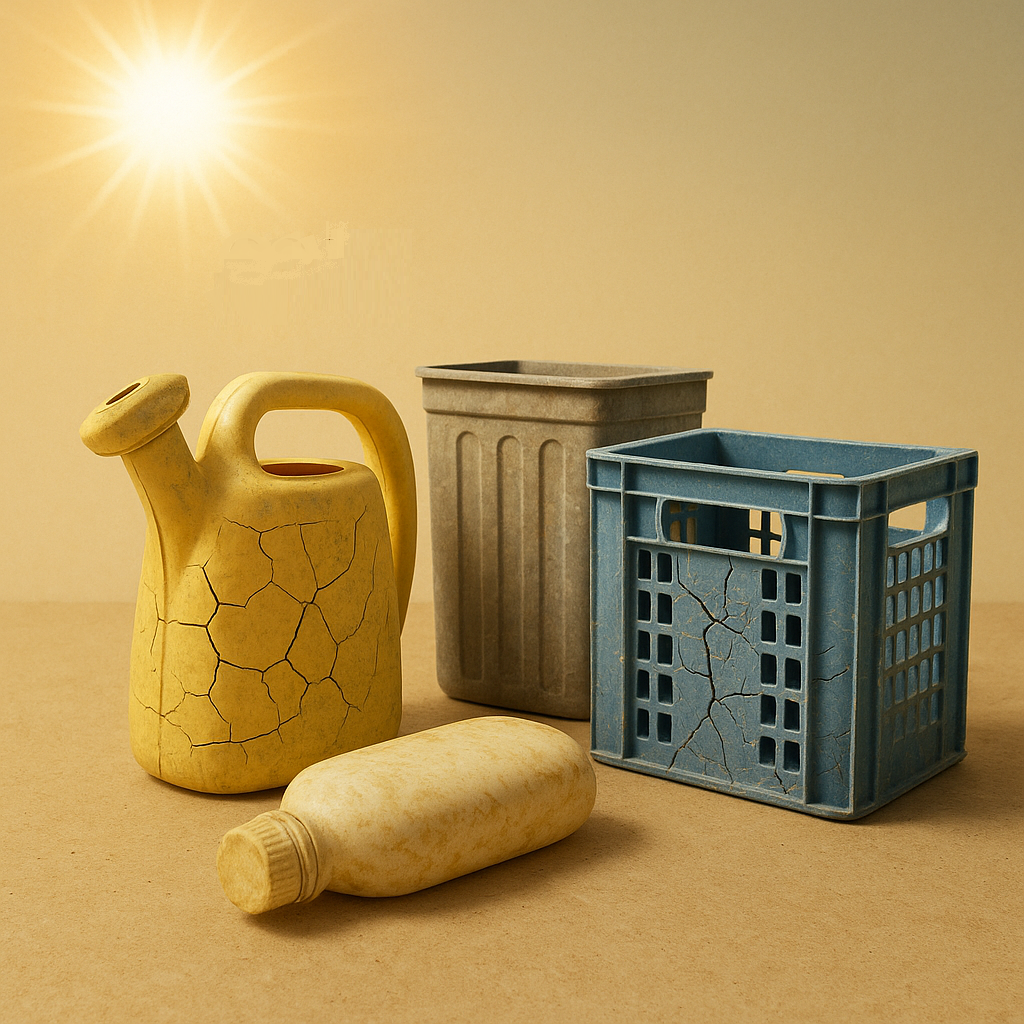Exposure to sunlight, especially under full summer sun with temperatures around 100°F, can significantly affect plastic products, particularly those made from thermoplastic polymers. These materials tend to degrade over time due to UV radiation, heat, and oxidative effects from the environment.
Here’s an overview of the main negative effects and potential damage:
🔥 1. UV Degradation
Ultraviolet (UV) radiation from the sun is the primary cause of polymer aging. It breaks down chemical bonds in the plastic structure.
-
- Visible effects:
-
- Brittleness: Plastic becomes stiff, fragile, and cracks easily.
-
- Yellowing or discoloration.
-
- Loss of gloss: Surface becomes dull or chalky.
-
- Micro-cracking: Which can lead to breakage under stress.
-
- Visible effects:

♨️ 2. Heat Effects (e.g. 100°F in direct sun)
Although 100°F (38°C) is well below the melting points of most thermoplastics, it can:
-
- Accelerate UV degradation,
-
- Temporarily reduce mechanical strength, especially near the material’s glass transition temperature (Tg),
-
- Cause warping or deformation, especially under load or stress,
-
- Promote migration of additives to the surface, forming films or sticky layers.

⚠️ 3. Combined Effects of UV, Heat, and Oxygen
This combination accelerates:
-
- Photo-oxidation: Chemical breakdown of polymer chains,
-
- Loss of mechanical properties: Tensile strength, impact resistance, elasticity,
-
- Aging in appearance and performance.

🔍 Impact on Common Thermoplastic Polymers
| Polymer | UV Resistance | Heat Resistance | Typical Effects |
| PE (Polyethylene) | Low (without additives) | Up to ~80°C | Yellowing, cracking, embrittlement |
| PP (Polypropylene) | Low | ~100°C | Color fading, surface brittleness |
| PVC (Polyvinyl chloride) | Moderate (with stabilizers) | 70–80°C | Yellowing, loss of flexibility |
| PS (Polystyrene) | Very low | ~90°C | Rapid UV degradation |
| PET (Polyethylene terephthalate) | Moderate | ~120°C | Yellowing, fine surface cracks |
| PC (Polycarbonate) | High (may still yellow) | 120–130°C | Loss of clarity, brittleness |
| PMMA (Acrylic/Plexiglass) | High | ~100°C | Slight yellowing, microcracking |
| PA (Polyamide, Nylon) | Low–moderate | 100–120°C | Absorbs moisture, becomes brittle outdoors |
☂️ How to Protect Plastics Outdoors
-
- Use UV stabilizers (e.g. HALS, UV absorbers),
-
- Use lightfast pigments,
-
- Apply protective coatings (paints, films, co-extruded layers),
-
- Employ good design practices (e.g. avoiding stress points),
-
- Choose UV-resistant materials or plastics formulated for outdoor use.
✅ Conclusion
With prolonged exposure to full sun and 100°F (38°C) heat, many thermoplastic plastic products will experience:
-
- Aesthetic degradation (discoloration, surface dulling),
-
- Loss of structural integrity,
-
- Premature failure or cracking.
For outdoor use in sun-intensive and hot climates, it’s essential to choose UV-stabilized materials and apply protective measures.



